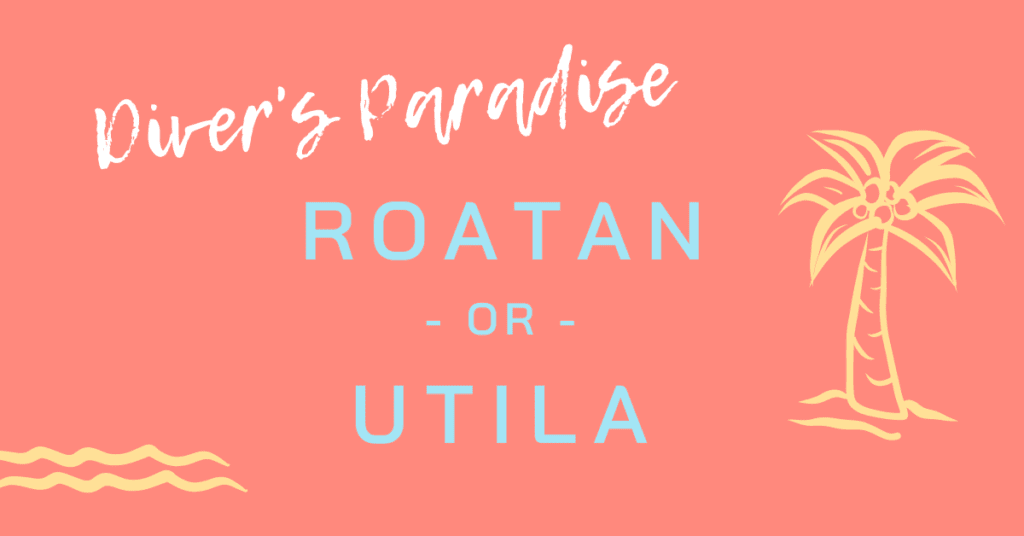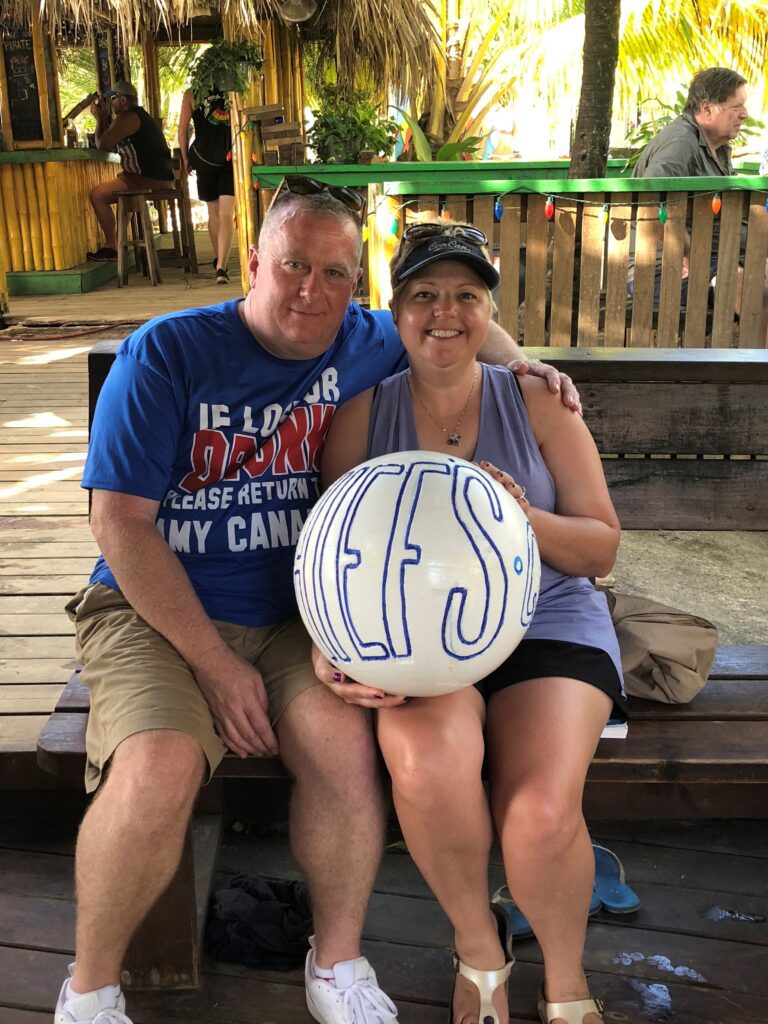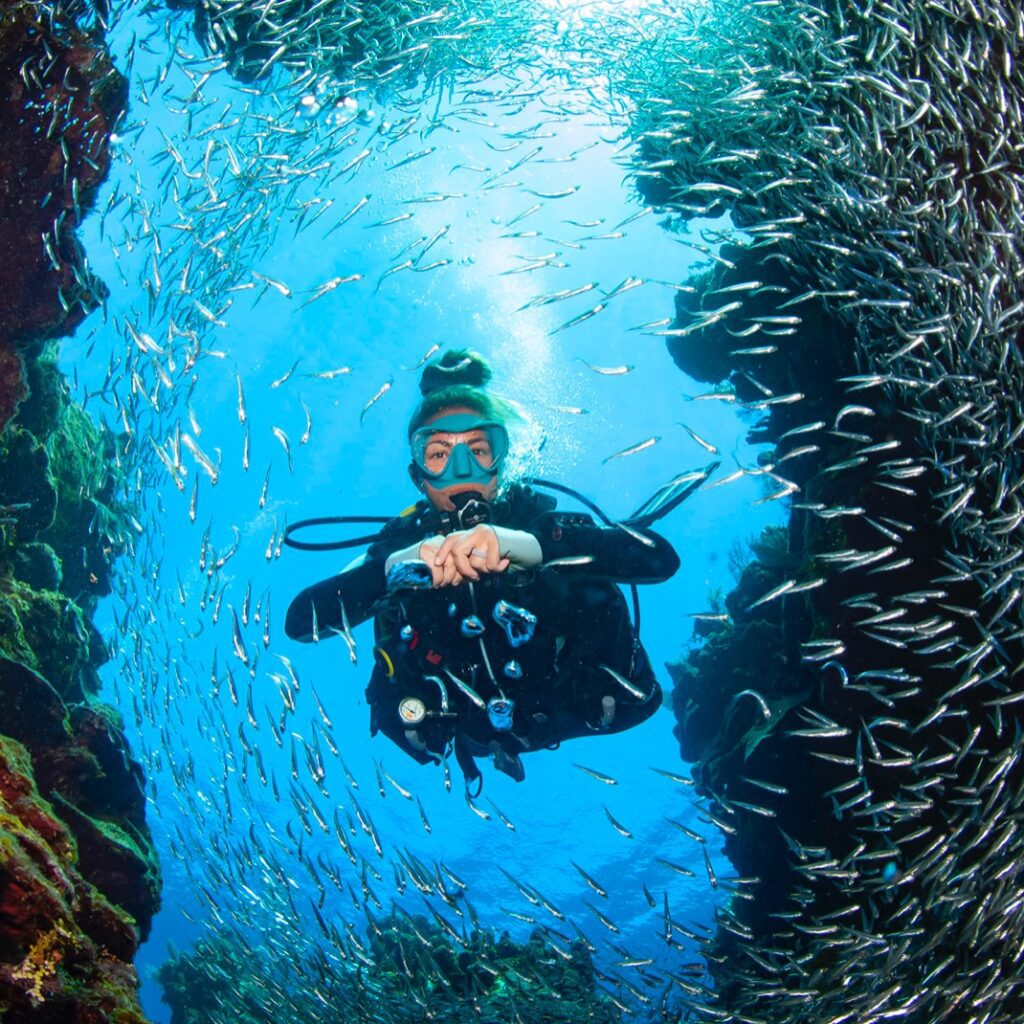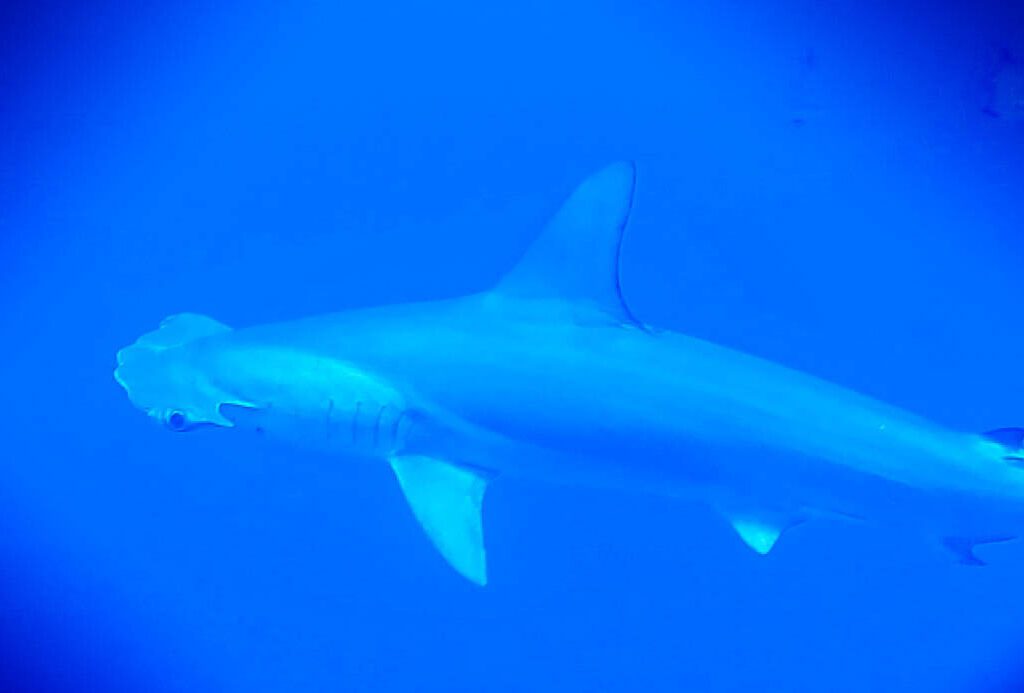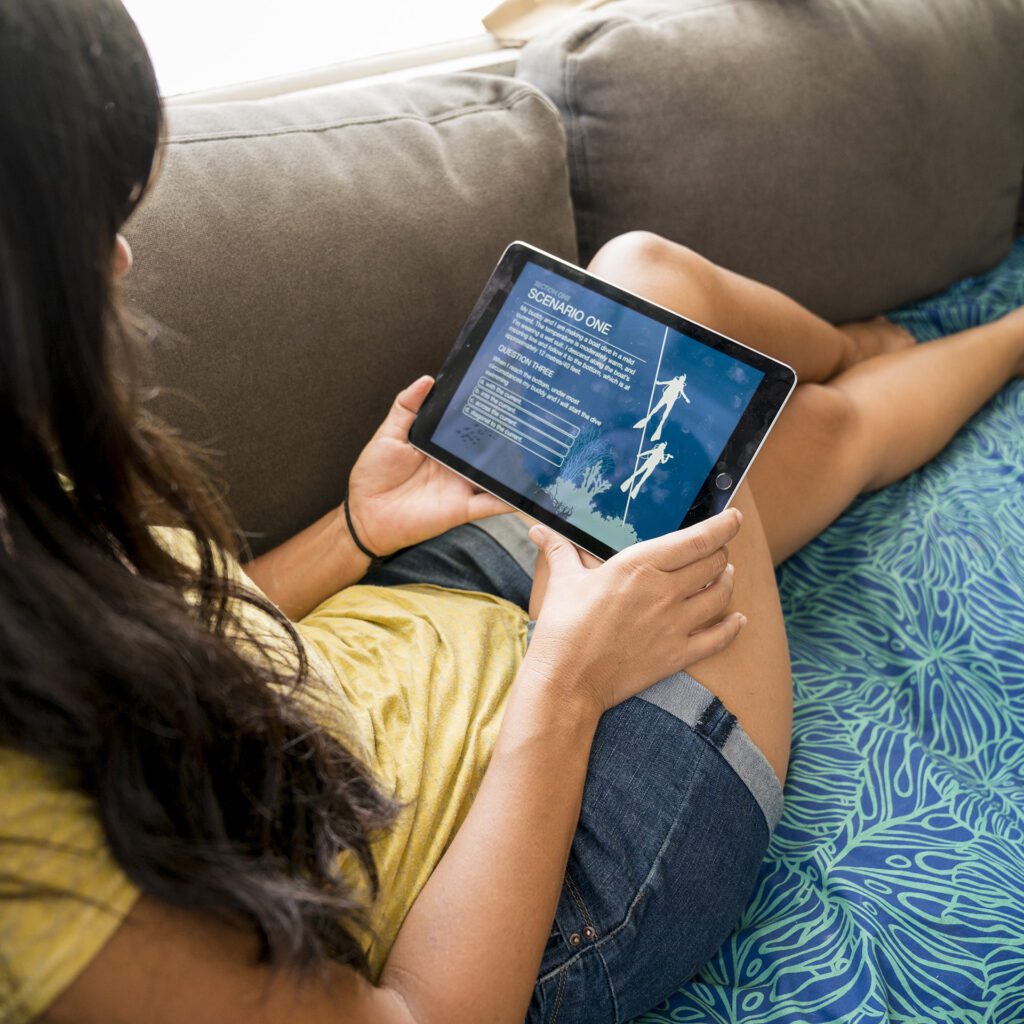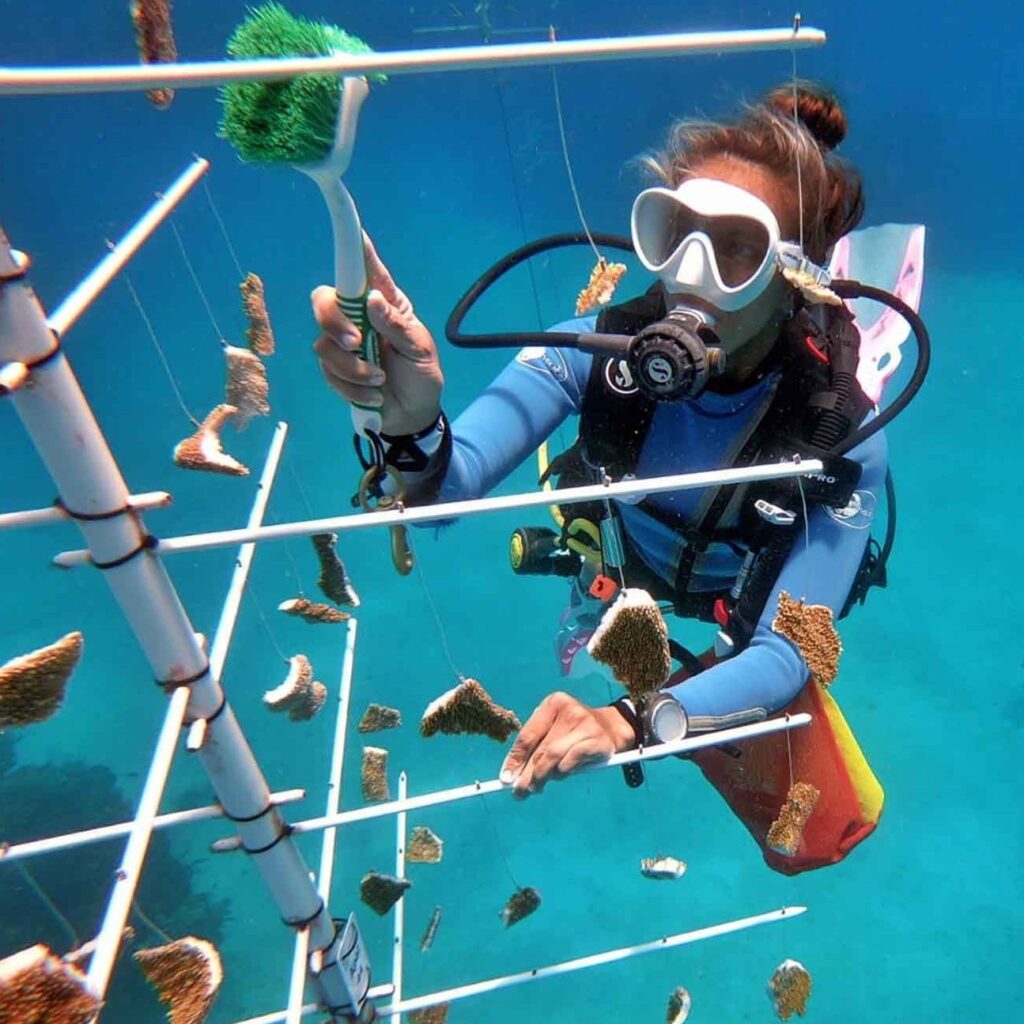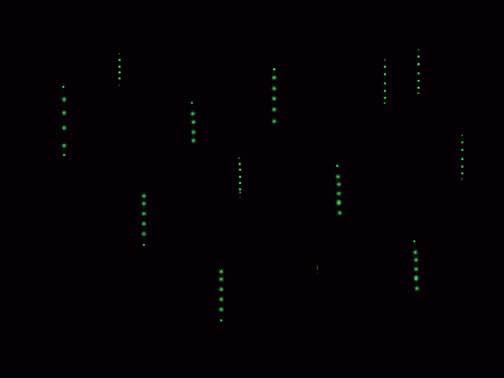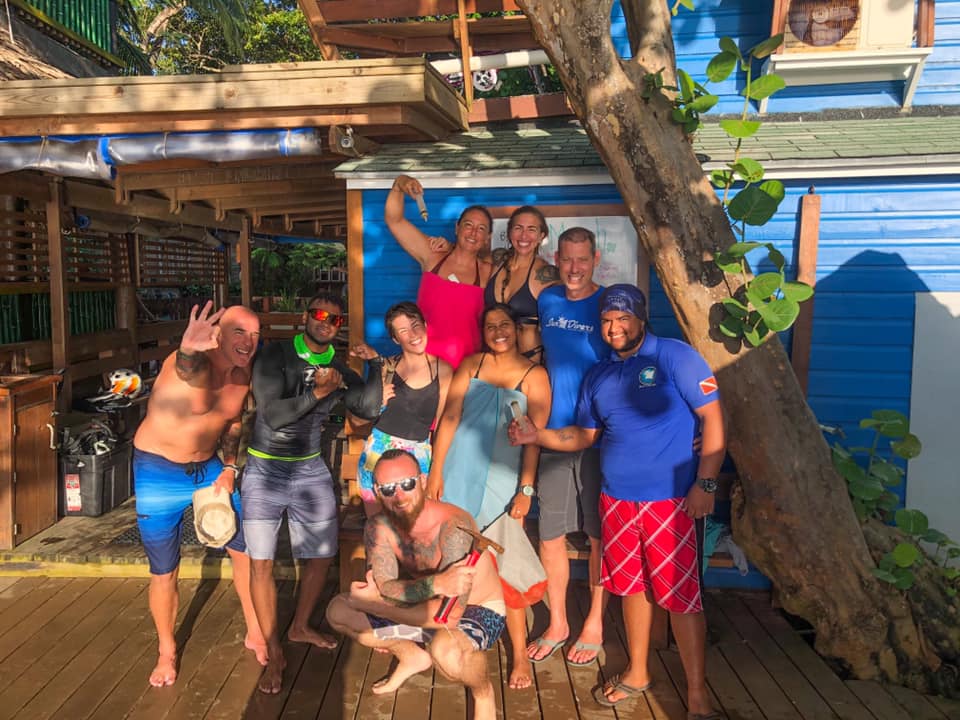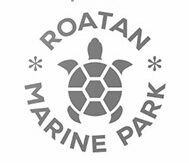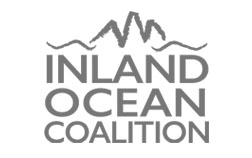Topic: Blogs
Roatan vs. Utila: Which is the best diver’s paradise?
Is Roatan or Utila better for diving? While they’re so close in proximity, they couldn’t be more different in terms of the experience they offer both under water and above on land. And if you’re already making the trek to one, it really is worth visiting the other. But if you must choose, consider a few factors to decide which island is more ‘your scene,’ including the marine life, dive center culture, island vibe and more.
Full disclosure: We’re lucky enough to live on the island paradise of Roatan – so it’s hard to make this 100% unbiased. But we’ve also been fortunate to travel the world and appreciate sound and honest advice that some travel blogs provide. So, in our attempt to pay it forward, here’s our take on the differences divers will experience when in Roatan and Utila.
Creature Features
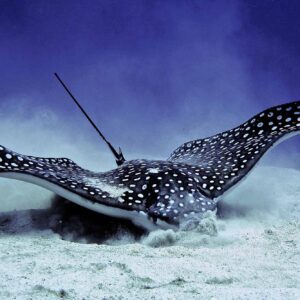
Up close encounters with eagle rays like this one are a common and always welcomed occurrence in Roatan.
Though they are part of the same MesoAmerican Barrier Reef system (the world’s second largest after Australia’s Great Barrier Reef) local conditions and reef protection efforts have a huge influence on the type of marine life that you see. We had always heard that Roatan is “fishier” and that laymen description is pretty fitting. In contrast to Utila, Roatan is teeming with life. Schools of fish, large and small, groupers, triggerfish, gobies, blennies, filefish – if you can name it, you will see it when diving Roatan. Eagle rays and sea turtles – hawksbill, green and even the occasional loggerhead – are almost guaranteed if you’re getting in at least a couple days of fun dives.
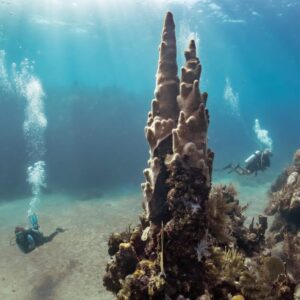
Thriving pillar coral like this one can be seen in abundance on Utila. Photo credit: Gil Sassi
What Utila lacks in its fishiness, it does make up for with its coral. We were consistently captivated by colonies of thriving pillar coral towering majestically with their polyps swaying in unison with the surge. Enormous elkhorn are the perfect focal point for photos, sun rays shining down upon them as if from the heavens (cue angelic singing). The coral life really is a sight to see.
We’ve always heard Utila is where you go to see the pelagic life in this region. Nurse sharks were certainly more prevalent than in Roatan, but the much sought-after whale shark remained elusive, and we were told that had been the case for much of the year.
Dive Site Variety
Both Roatan and Utila are fortunate to have a fringing reef, encircling the islands and allowing for diving on all sides. But with an area of 32 square miles, Roatan is almost twice the size of Utila equating to more reef to explore and a wider variety of dive sites. There are literally hundreds of Roatan dive sites around the island with a wide variety from wall dives, macro, swim throughs, wrecks and more.
Dive Center Culture
One of the more striking differences between Roatan and Utila is the dive center culture. Most dive centers in Utila are focused on being training centers for those who’ve decided to buck the traditional path to professionalism and pursue an exciting and adventurous career in the dive industry. They offer longer-term lodging accommodations with zero to a hundred packages for people who need to work from the beginner level to a professional track.
This translates into an energetic and international vibe from throes of young people who are incredibly passionate about the ocean and diving. As a fun diver, you sometimes can tag along on the training dives at a discounted rate.
This also translates into a need for bigger boats to accommodate more students in addition to fun divers. Bigger boats, usually means slightly longer travel times and many of the shops have an early-morning departure time of 7:30 a.m. compared to 8:30 a.m. or 9:00 a.m. more typical on Roatan.
So, prepare yourself for some bleary-eyed dive trips in Utila, especially if you want to take advantage of its well-known night life.
Island Night Vibes
As a mecca for youth who are seeking the sea as a way out of the normal nine-to-five corporate culture, it’s no surprise that Utila is also known as the “party island.” As one of our divers stated, “I felt like an old man.” And he was only 30 years old!
But ‘age ain’t nothin’ but a number’ and if you’ve got the energy, Utila’s got the night vibes. A stop off at the famous (or infamous) Skid Row to witness – or even participate – in the guifity challege is a must. What is the guifity challenge you ask? Well it involves copious amounts of local, herbacious alcohol and spinning until you want to yak – all for a free Skid Row shirt. Totally worth it, right?! Full Moon parties celebrating recent Divemaster and Instructor certs at the Jade Seahorse are known to be a good time. And Underwater Vision’s Trivia Nights are a who’s who of DMTs and instructors in the making.
Would you do this for a t-shirt? Not gonna lie, we might!
By contrast, Roatan’s party crowd is a more mixed demographic. It’s young and old, local and expat, and pretty much always a good time though there’s probably a lot less “swiping right” opportunities than on Utila if you catch our drift. There are monthly EDM dance parties by the beach at Tequila Jack’s in Brisas del Mar, live music and music trivia nights weekly at the iconic Sundowners Beach Bar (next to Sun Divers), late night dancing at Frank’s Hideaway and many, many more beach bar hangouts in between. We LOVE weekends at the Roatan Island Brewing Co. – I mean, where else can you find a killer brewery in the middle of a tropical rainforest? And the Roatan Local Market rotates locations and creates a cool hangout spot where you can also support local small businesses.
Accommodations & Remote Work Challenges
Lodging options is probably one of the starker differences between Utila and Roatan. While Roatan has something for everyone from hostels and dorm rooms to boutique hotels and luxury vacation rentals, options in Utila are a bit less varied. Looking for a place to stay in Roatan? Contact us for our list of “diver approved” lodging options for every budget size.
People often describe Utila as a backpacker locale, and the lodging options show why. There are many hostel options, budget AirBNBs, but luxury or boutique accommodations are very limited. We stayed at one of the newer hotels called
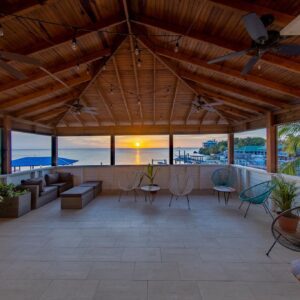
Roatan Beach Desk is one of the places where you can work in both beautiful and functional spaces.
the Manurii Boutique Hotel and found it to be a beautiful little boutique oasis that we’d happily return to – though one of us (who’s 6’4”) would appreciate a hotel with a king bed.
While we were there solely for vacation and happy to disconnect, we experienced a few long-lasting power outages that we noted would make working remote from Utila quite challenging. We were told that daily power outages could be expected and that sometimes there are days when you only have a few hours of electricity. This can be an excellent forcing function for anyone who needs to learn how to disconnect and live in the moment, but would present challenges if you’re looking to work while you get your wanderlust in.
We find Roatan to be the perfect paradise for digital nomads with many accommodations providing high speed cable internet and infrequent and usually scheduled power outages.
So how to choose?
Don’t! Visit both and contrast and compare for yourself!
But if you have to decide, think about what element of travel is most important to you and which island is going to fulfill that best. Maybe you want to dive hard and play harder and need a night life scene that can meet your night owl tendencies. Or you have a certain living standard you want to meet wherever you rest your head and want a wide variety of dive experiences on the daily.
Wherever you choose, we promise the Bay Islands will not disappoint and you’ll only leave wanting to come back for more.
Looking for more personalized advice to help plan your dive trip? Feel free to contact us for more details on diving and vacationing in Roatan and the Bay Islands.
Remembrance and Restoration: The Story of The Chief’s Quarters
The Chief’s Quarters is more than just a dive site on a map. It’s a remembrance of a great man who was a medaled Navy officer and lover of the sea. It’s also a site that is a training ground for new scuba lovers, an exploration ground for experienced divers and the birth site of many new coral colonies as the designated out planting site of the Roatan Marine Park Coral Restoration program. Here’s what makes The Chief’s Quarters special to Roatan and to the people who dedicated it to our dive community.
How The Chief’s Quarters came to be
Like so many of us, Roatan is Dave & Amy Canaan’s happy place. When they decided to make Christmas gifts more about experiences than presents, their daughter Madison chose for the family to get Open Water certified in Roatan. Now its their home away from home; where they’ve made many happy family memories and have connected with many newfound friends! And come 2022, Roatan will become their actual home – just to give you a sense of how much they love this place!
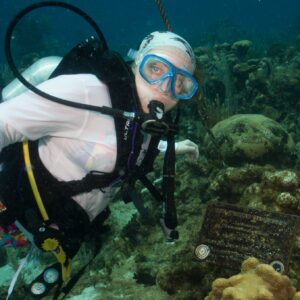
The Chief’s granddaughter Madison at the dive site dedicated to her grandfather.
And while they’ve been fortunate to share this happy place with many friends & family, the one person they never got to share it with was Dave’s dad, Richard Canaan – the very person who inspired Dave’s love for the ocean.
So, while Dave and his family couldn’t share Roatan with Richard in life, he decided they’d share it in spirit. On February 23, 2018, the Canaan family dedicated the site to his father through the Roatan Marine Park’s Name a Dive Site program.
The Name a Dive Site program offers people a way to demonstrate their commitment to Roatan’s community while honoring loved ones. It also supports the RMP Marine Infrastructure Program funding the installation of mooring lines that help increase diver access to the Mesoamerican Reef in Roatan, while decreasing mechanical damage to the reef caused by anchoring.
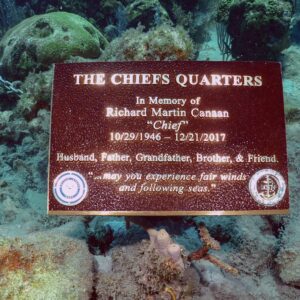
The Chief’s Quarters dedication plaque.
The dedication of the site included the installation of a plaque that sits at the base of the mooring line reading “…may you experience fair winds and following seas.” According to the Department of Navy – Navy Historical Center: ““Fair Winds and Following Seas” is really two quotes originating from different sources. The two quotes are a nautical phrase of good luck–a blessing as it were–as the person, group, or thing it is said to departs on a voyage in life.”
Over the years, Dave and Amy have shared the site with many of Richard’s loved ones including a group of 49 friends and family members who took a cruise to Roatan and were able to snorkel and dive the site. Recently, Dave’s sister Wendy did her Discover Scuba Diving experience, getting to connect with the memory of her dad and the ocean that he loved from the beautiful depths below. She’s now on her way to becoming Open Water certified.
Meet ‘The Chief’
Richard Canaan was a husband, father, grandfather, brother and friend. He was also a diehard Kansas City Chiefs fan and a Navy man, earning the patriarch of the Canaan family the nickname and title of ‘The Chief.’
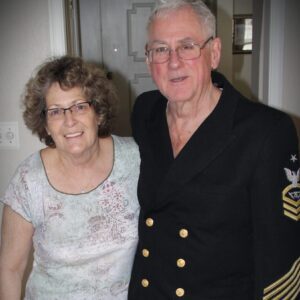
Richard Canaan, a.k.a. The Chief, with his wife Gayle Canaan.
The Chief who dedicated 22 years of his life to the U.S. Navy and then another 22 years in the Civil Service, was stationed in Japan, Norfolk, VA., San Diego and Port Hueneme Calif., and Jacksonville, FL.
One of Dave’s fondest memories is flying to Hawaii as a young boy (twice) and sailing on the Navy ships with his father back to San Diego.
Richard was always a proud Navy man who would stop and talk to any other fellow Navy man regardless if it was a grizzled old vet like himself or someone newly enlisted. He could always be seen wearing a navy hat from one of his service stations or drinking coffee from a cup emblazoned with a ship on which he had served. Right up to the day that he lost the fight with Alzheimer’s he was always Navy proud. He might not have remembered everything he did for his family, friends, and Country, but we will never forget.
Why we love The Chief’s Quarters
We like to say we’re more than a dive center, we’re a community center for diving fanatics. And Amy and Dave have been a longtime part of that community, fun diving many times a year and supporting our team from afar when the pandemic had put a halt on the fun.
Over the years they have become as much a part of our family as we’ve been of theirs. And the Sun Divers team has been honored to get to be there for so many fond memories, including those that have happened at The Chief’s Quarters. Which is why the site means a lot to us.
But “Chief’s” as we call it, is a Roatan dive site that means a lot to the whole community. That’s because Chief’s Quarters is a dive site that’s perfect for everyone: snorkelers, new divers and experienced divers. The mooring line sits on a sand patch at 20 feet which offers an expansive area for instructors and students to perform Open Water and Advanced Open Water skills, and at night it becomes the perfect place for divers to safely shut off their lights and become bewitched by the bioluminescence phenomenon The String of Pearls.
From there it gives way to long and slowly descending plateau at 40-50 feet, and then the wall that drops to 120 feet before it hits another sandy decline. It’s a common area to spot both Hawksbill and Green Turtles.
And its memorial plaque is diligently protected by Threespot Damselfish. Like a good mate, he’ll dash out and squawk at you for even laying so much as a finger on The Chief’s plaque. It’s always hard not to LOL underwater at the fishes’ hyper territorial protectiveness. Dave and Amy are convinced there is a little bit of the “Chief” in that fish who can be a bit ornery!
The Chief’s Quarters is also an important site for the future of the Mesoamerican Reef. It is the designated out planting site for The RMP Coral Restoration Program since it meets the optimal depth requirements for Elkhorn and Staghorn. Since June 2020, restoration efforts have yielded out-planting of 340+ fragments.
In September 2021, Amy decided she would become a certified Coral Ambassador. She was excited about the opportunity to leave the Roatan reef a bit more beautiful (and healthier) than she found it, but she was ecstatic when she learned that the very place these activities would happen was the site dedicated to her father-in-law.
Want to check out The Chief’s Quarters for yourself?
Contact us to plan your next diving trip in Roatan. “Chief’s” as we call it will likely be one of the many spectacular Roatan dive sites you have the chance to explore.
Want your own dive site?
Interested in memorializing someone you love – or just your love for Roatan and diving? Consider supporting the Roatan Marine Park’s Name a Dive Site program. You can find more details here.
The spell of the silversides
Roatan offers such an amazing variety of dive sites that are accessible all year. Each site has its own unique features from towering walls, steady drifts, and deep caverns… often, all three and more.
But, during brief windows of time, some of the sites are punctuated with a once-a-year bonus. During the month of August, we experience one of the coolest phenomena: the spawning of Silversides.
What’s so cool about Silversides?
Silversides by themselves are an inconspicuous fish about two inches long with a white-silvery sheen. However, during their annual spawning, the silversides will form massive schools in sheltered areas of the reefs. They will take up residence in some of the many swim throughs and caverns prolific around Roatan.
This experience can be mind-blowing to divers. Imagine entering a swim through…The rays of sun light fight through the many cracks and holes creating lustrous streaks that reflect off the bottom. As you get further into the cavern you begin to see the streaks of sun broken up by flashes of light in every direction. Soon, you are surrounded by a mesmerizing light show as the schooling silversides surround you. They simultaneously block the light from above and reflect it in constantly evolving patterns. As you swim through the school, the fish will open up a small tunnel while still flashing their disorienting shapes.
The ever-evolving synchronized movements combined with the flashes of light have engulfed you in their spell. Before you know it, you have spent twenty minutes in one place – losing all sense of up, down, forwards, and backwards – but you are loving every second of it.
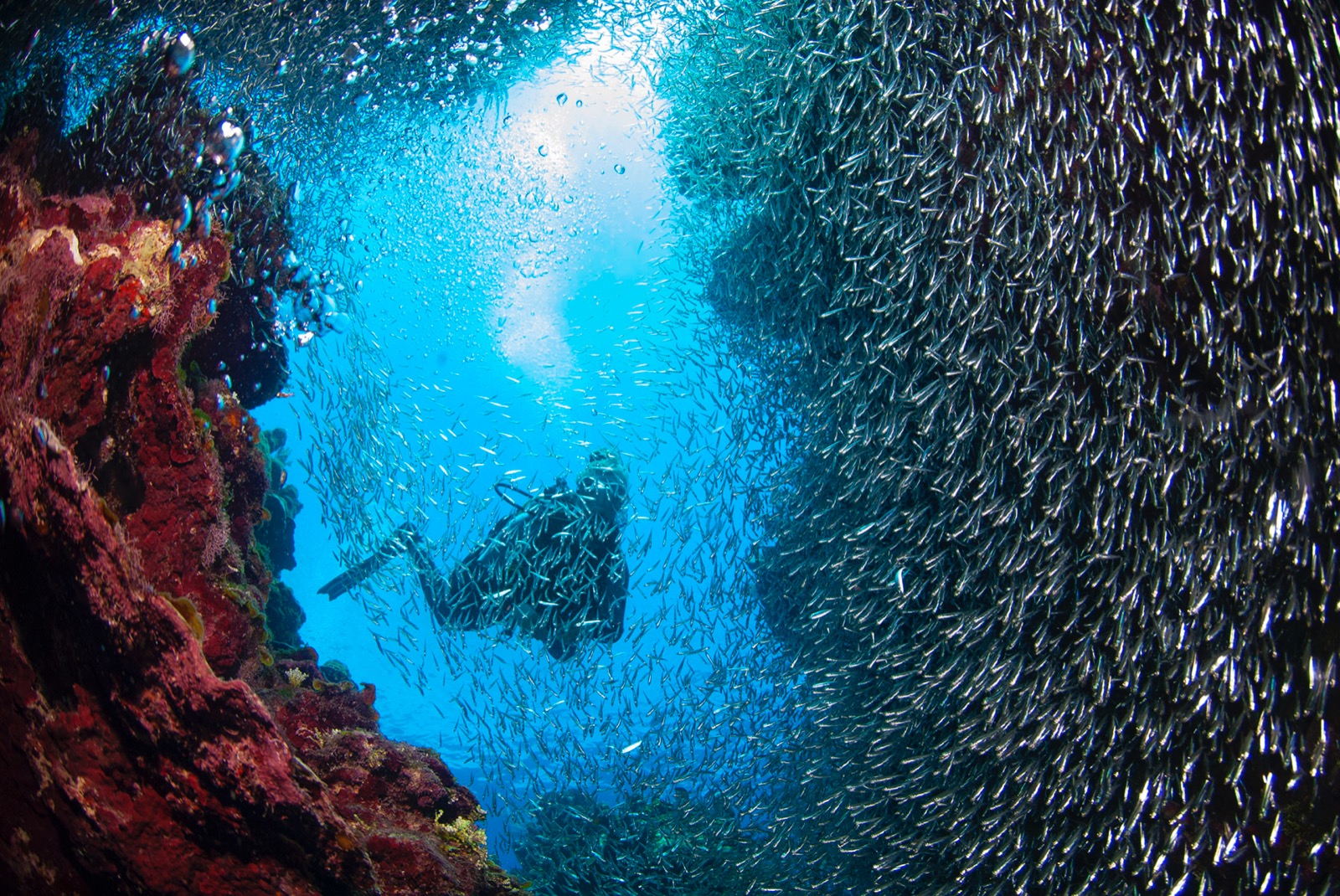
©️ Antonio Busiello
Why do Silversides just appear?
Scientifically speaking, the silversides are here for a reason. Millions of the Atlantic silversides will swell together for their annual spawning May-July. About five to 20 days later, newborns are hatched in what is called “broadcast spawning”. They travel in massive swells of schools as a form of protection and fill many nooks and crannies of the Mesoamerican reef for refuge. The silversides will feed on fish larvae, eggs, and zooplankton. Each fish is about two inches long, but the schools can feel like they go on forever. Their lifespan, unfortunately is much shorter. They can live up to two years, but many live for one as they also serve as a primary prey from larger fish and squid on the reef.
Where can I find schools of Silversides?
Some of the most popular spots for silversides include Blue Channel, Dolphin Den, Mary’s Place, Spooky Channel and more. But the schools can materialize overnight in any of the many caverns around the island.
Want the Silversides to put a spell on you?
Sun Divers will make sure to include these sites in your itinerary during your stay in August.
Contact us to plan your trip today.
Shark! Your sighting can help science
Sharks: a bucket list sighting for almost any diver, striking fascination and sometimes a small dose of fear in the hearts of us all. We’ve spotted three scalloped hammerheads on dives in just two months, making us more than a bit obsessed here at Sun Divers. And we’re not the only ones.
A new passion project in Roatan supported by the Roatan Marine Park and headed by Simon Gulak, shark biologist and founder of Sea Leucas, aims to shed some light on the little known life of sharks here in Roatan and the greater Bay Islands.
Share your shark sighting
The moment is magical. You hear the tank bang and direct your gaze to the blue. At first it’s a shadow and then there’s that undeniable dorsal fin. If you’re an underwater photographer you’re scrambling to not be all thumbs. If you’re not, you’re likely fixated. Witnessing firsthand the power and finesse of the ocean’s apex predator in the wild is something you never forget.
It’s an experience you want to share with everyone. You’ll no doubt talk about it. Post about it. Hopefully add it to our “Best Sightings of the Month” board. And now you can also share your sighting to help build the first shark count database in the Bay Islands.
Sightings help science
Honduras designated all 240,000 square kilometers of its waters as the first shark sanctuary in the Americas in 2011. Yet, we know very little about shark life, behavior and abundance (or lack thereof) in Roatan and the Bay Islands.
Limited data means limited ability to protect these beautiful creatures who are not only crucial to the health of marine ecosystems, but have been proven to be of more value to our economies when they’re alive and thriving than served on a menu.
One of the most important data points that can help protect sharks is simply establishing a baseline of their abundance. This baseline is something that does not exist in Roatan and the Bay Islands….yet. RMP and Sea Leucas have established the first ever database for shark sightings with the hopes that the entire community will contribute.
Adding your sighting is simple. Just visit the RMP Shark Sightings page to submit information about your sighting including when, where and what species was seen.
Sightings to date have included scalloped and great hammerheads, oceanic white tips and silky sharks.
What will we spot next?
The best way to find out is to dive in!
To E-Learn or Not to E-Learn?
That is the question that a lot of people have when first considering achieving a PADI certification. But, like most things in life, there isn’t a one size fits all approach to SCUBA diving certifications. And that’s actually a good thing, because it allows you to personalize your diving education journey.
So how do you know if E-Learning is right for you?
Consider three things when deciding if you should opt for the PADI E-Learning vs. a full course at your dive center of choice. 1) your personal learning style, 2) your vacation length and 3) your budget.
But, before we dig into whether E-Learning is right for you, it’s probably best that you understand exactly what your options are! We’ll use the PADI Open Water course to highlight the differences.
The PADI Open Water Diver course includes three parts:
Knowledge Development, Confined Water Dives, and Open Water Dives. Knowledge Development covers the principles, concepts and terms you need to know for dive safety and enjoyment. During the Confined Water Dives, you learn and practice scuba skills in the shallow waters of our bay (other dive centers might use a pool). Then, to complete training, you will apply and demonstrate what you’ve learned through four Open Water Dives upon the beautiful Roatan reef.
Confined water skills might not be required for the certification program such as Advanced Open Water or Specialty Certifications.
There are two ways to approach the Knowledge Development portion of all PADI certification programs:
One is through PADI E-Learning which is an online training platform that includes a mix of written education and videos. The knowledge reviews, quizzes and final exam that you’d normally take on site at the dive center are administered for your completion online prior to show up to the dive center for your course. When you start the in-person part of the course with your dive center, they will administer a set of questions for you to answer known as a “Quick Review.” This allows the instructor to see where there might be knowledge gaps that they will then help fill through discussion with you.
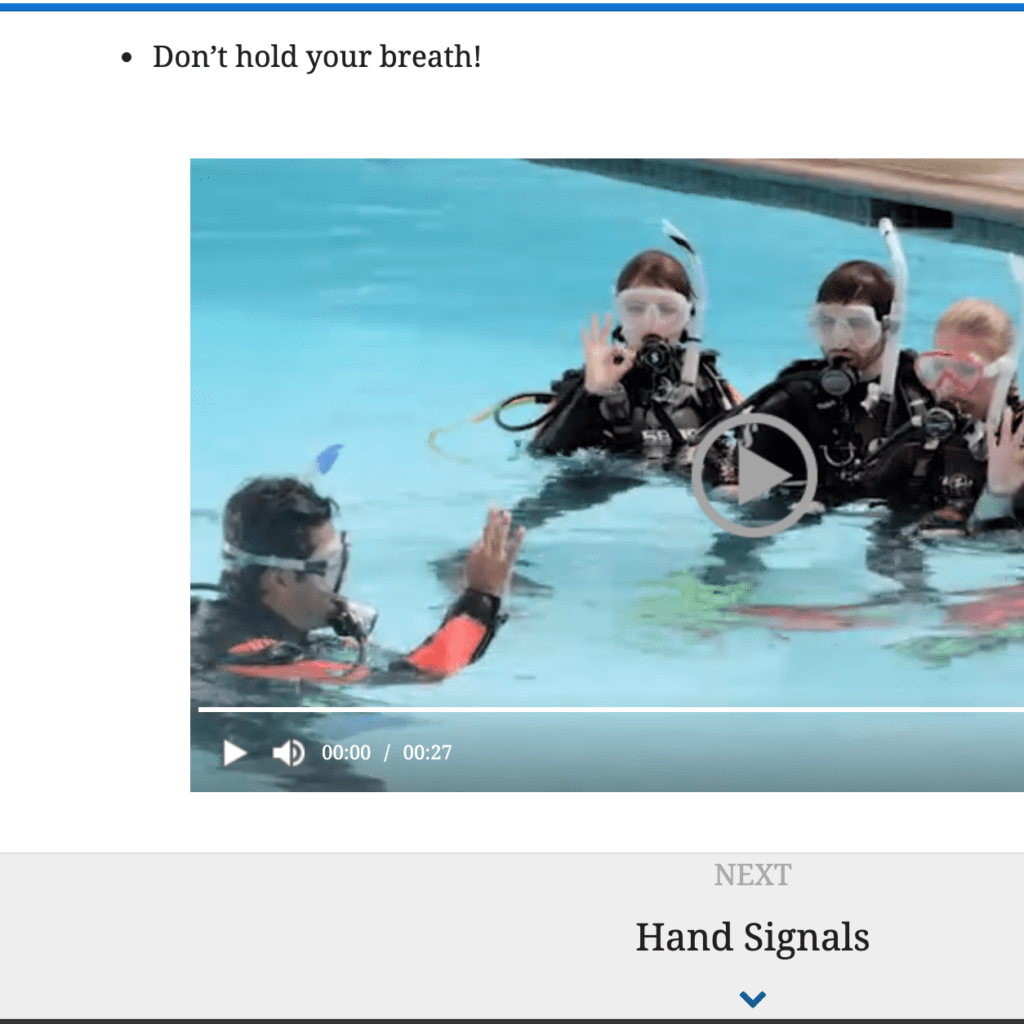
Screenshot of the multimedia PADI E-Learning platform
The second option is to take the “Full Course” at your dive center. With this option, you read a hard copy manual and answer the knowledge reviews in advance, and also must watch a series of videos. You then review the content of each of the five knowledge development sections with your instructor. With this option you’ll be able to ask more questions and hear anecdotes from your instructors experience that provide additional context to the theory. Quizzes are taken on site and reviewed with your instructor, as is the final exam.
With both options, you still must complete the confined and open water skills in person – there are just some things that can’t be done in a virtual world (yet!).
Is E-Learning right for your learning style?
Spoiler alert: Learning “styles” are a myth! Many of us have probably been told that we are either predominantly a visual, auditory and kinesthetic learners. And that when trying to process and learn new information, it should be taught to us in the style that’s our dominant learning style.
Cognitive research today has thoroughly debunked this myth. Plus, the PADI e-learning platform is an engaging mix of reading, informational images / graphics and videos hitting on both visual and auditory learning. Combine that with the kinesthetic confined and open water skills and you’ve used all senses to learn.
So if you think e-learning is not for you, you might just think again. Unless you just really prefer the experience of a “real” book vs. more screen time.
Will E-Learning give you more time to enjoy your vacation?
Absolutely. A typical full course will take 3 – 3.5 days to complete based upon your own rate of progress. E-Learning typically takes 2.5 – 3 days. That means more time for you to maximize your vacation – either moving on to fun diving after certification or freeing you up to incorporate other activities into your vacation.
Does E-Learning Cost More?
In short, yes. But as the saying goes, “time is money” and it’s just a matter of how much your time – especially your vacation time – is worth to you. Compare E-Learning prices here to decide whether it’s worth it to you.
Now that you know some of the differences between E-Learning and PADI’s traditional methods of instruction, it’s time to decide which is right for you. Still have questions? Don’t hesitate to reach out and ask!
The case for coral nurseries in Roatan
As you make your way for your safety stop at Seaquest, all of a sudden it comes into focus: An underwater forest of manmade tree-like contraptions. Little bits of coral dangle from these metal ‘trees’ like Christmas ornaments. What you’ve happened upon is the Roatan Marine Park’s Coral Restoration Nursery. The nursery is a super cool location to spot slender file fish, squid squads and even turtles and eagle rays – but it’s purpose is even cooler than that. The nursery is designed to ‘grow’ coral fragments that can then be outplanted onto the reef in order to increase coral coverage with more resilient coral species.
Wait – how do you grow coral?!
First it starts with the coral fragments. Broken bits of Elkhorn, Staghorn and Prolifera coral (which is a hybrid of the two) are recovered from the reef and then hung from the trees. Here they can avoid predators such as fireworms and snails while benefiting from increased sunlight and well-circulated water free flowing amongst the trees.
Much like a plant nursery, these smaller fragments are essentially nursed back to health (pun intended!), so that they can grow into larger, stronger fragments that will survive being outplanted back onto the reef. The more mature corals are then taken to the Roatan dive site Chiefs Quarters where they are “planted” using two-part epoxy. Many times they are positioned near existing coral colonies of the same species which indicate that the location is an area where the coral transplants will thrive.
Why do corals matter anyway?
Reefs cover only .2% of the ocean floor yet sustain 25% of marine life. They also contribute greatly to our lives providing recreation, billions of jobs and coastline protection. Not to mention, the joy, peace and exhilaration we experience when we get to connect underwater to the beauty of the reefs.
That’s a pretty big job for such a small population of coral. Yet, this all-too-important and already limited ecosystem is under attack from warming sea temps, diseases such as Stony Coral Tissue Loss Disease damage from ships of all kinds, and destruction from construction such as port dredging.
As coral coverage diminishes, so will the home to thousands of species of fish, invertebrates, marine mammals and more. So will our ability to spark joy from exploring the reef while scuba diving. And so will the protection from storms and erosion, as well as the foundation for billions of jobs worldwide.
In short, a world without corals is not one we’re excited about living in or raising our children to have to struggle with.
What’s the coral situation in Roatan?
The MesoAmerican Barrier Reef in Roatan is under the same catastrophic stressors as reefs around the world. To help offset the loss of coral colonies seen here on the island, The Roatan Marine Park has developed a nursery with 20 trees. Since the nursery’s installation in 2019, over 300 coral fragments have been outplanted. The next steps: continuing to expand the program, while also monitoring the outplanted coral for future growth and spawning (to ensure corals are self-propagating).
So now you’re saying ‘Cool, I want to help plant coral!’
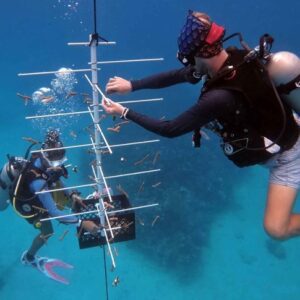
Sun Diver team members Nick Griffiths and Ana Meza attach coral fragments to a tree.
You’re in luck. Divers have an opportunity to become volunteers through the Coral Restoration Ambassador program. As a Coral Restoration Program Certified Dive Center, we can certify you so that you
can perform basic tree maintenance, help repair trees that have been damaged from storms and surge, and even assist with outplanting and data monitoring. There are two certification levels and the course can be completed in just a couple days. Learn more about how to become a certified RMP Coral Ambassador.
If you’re not on the island and won’t be anytime soon: what are you waiting for? Book your ticket!! But you can also support form afar by donating to RMP’s program. Donations help fund nursery operations, permits to keep the program running, and ongoing analysis to improve future program decision.
Okay, so what is the String of Pearls?!
So you just finished your first Roatan night dive and experienced the globally rare “string of pearls” phenomena. The only thoughts that go through your mind are “have I entered the Matrix?” or “Who spiked my water?”.
Check out this cool TED Talk by bioluminescence specialist and Ocean Research and Conservation Association founder Edith Widder.
What you have seen can only be described as mind-altering and, possibly, life changing.
Imagine yourself in complete darkness. Each flurry of movement sends “sparks” through the water. The light gives you the sense of racing through the universe surrounded by a galaxy of stars. You are already amazed at the experience – THEN the magic happens – your eyes begin to focus on the strings of sparkling lines of brilliant green lights that flash in concert throughout the water.
So what is it that you’re exactly seeing?
The legend of the “String of Pearls” has a many homegrown explanations. The most common is simply that no one really knows what they are. While that isn’t completely true, sometimes the marvel of the experience is simply more romantic without knowing the details.
The truth of the matter is that there is real romance involved.
The real story behind the “String of Pearls” starts with a microscopic crustaceans
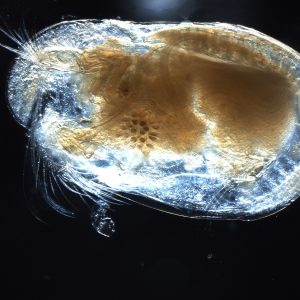
Ostracod
called Ostracods. These tiny creatures emerge from the depth about an hour after sunset to begin their bioluminescent courting ritual which consists of males excreting strings of “vomit” blobs of bioluminescent mucus – all in the name of love… And the Ostracod chicks dig it!
Each of the strings produce an intricate series of vertically progressing flashes to attract non-luminescent females of the same species. The displays typically consist of nine to 13 pulses, three bright, longer pulses followed by six to ten dimmer, quick pulses. The length of each train of displays is typically 50 to 70 centimeters with each pulse lasting a second or less and ranging from millimeters to centimeters apart.
Divers who experience this amazing sight often struggle to describe what they just experienced but are aware that what they witnessed was uniquely Roatan.
Now you’re asking yourself… how can I see the “String of Pearls”?
Every night dive will be a thrilling adventure but take a glance at the moon stages. If you happen to be on the island when there is a new moon (ie. No moon), your chances just increased dramatically. Check out more on our night diving at Sun Divers Roatan here.
SCTLD: Be part of the solution
We’re not the only ones on Earth trying to combat devastating diseases these days. The MesoAmerican Reef in the Caribbean has been facing its own pandemic caused by new disease called Stony Coral Tissue Loss disease.
Divers will ask us from time to time about the difference they are seeing in the coral. Many are sad to hear about the havoc this disease is wreaking on the reef system of their beloved Roatan and want to do something to help. Luckily, there is hope and divers can be a part of the solution.
So what exactly is Stony Coral Tissue Loss Disease?
The truth is that the scientific community is still working to understand exactly what SCTLD is. But, there is strong reason to believe that the disease is bacterial, based upon the efficacy of antibiotic treatments (more on these in a minute!).
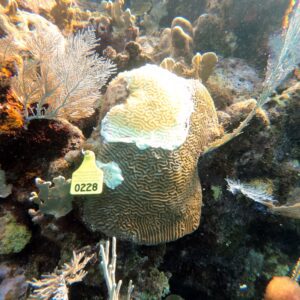
It effects over 24 types of stony corals. Iconic pillar corals, big and beautiful boulder brain corals and star and starlet corals being the most susceptible. The disease is characterized by freshly exposed white skeleton that usually forms in circular lesions, first appearing along the borders of coral colonies.
Do we know where it came from?
The disease first came on the radar in 2014 in Florida. That year there was a trifecta of incidences that wreaked havoc on the reef system there:
- 2014 was (and still is) the hottest year on record
- Coral colonies were getting hit hard with bleaching and
- the dredging of the Miami Port was badly damaging the reef. This trifecta made coral colonies weaker, less able to fight against diseases like SCTLD.
From Florida, the disease quickly spread across the Caribbean, ultimately making its way to Roatan in September of 2020.
Is there a cure?
There is still not a surefire way to stop SCTLD. However, antibiotics, specifically amoxycillin, have been proven to stop the progression of the disease. The amoxycillin in powder form is mixed with a special marine epoxy and then administered to coral colonies through syringes. Depending upon the coral species, the efficacy rate can range between 60-80%.
How do I help?
This all sounds catastrophic, but there is hope. And you’re part of it. Here’s how you can help:
- Decontaminate your gear. Pathogens can survive in scuba diving and snorkel gear. This can cause the disease to spread internationally. Help avoid this by soaking your gear in a solution of water with 1% bleach. Avoid further environmental contamination by allowing this solution to sit in the sun and breakdown for one day. Then dispose of it.
- Remember the 3 Ts: Don’t Touch, Take or Tease. Touching diseased coral and then healthy coral can cause transmission of the disease. But this isn’t the only reason you shouldn’t touch the coral. Coral are actually fragile animals. If you touch them, kick sand in them or hit them with your instruments, fins or body, you can seriously harm them. Learn more about Coral Etiquette from the NOAA.
- Volunteer for a Treatment Dive: At Sun Divers, one of our core values is to Always be Eco-Active. We believe that we’re not here just to enjoy the splendors of the ocean, but to protect them. One way we are acting as good stewards of the reefs, is conducting bi-weekly SCTLD treatment dives. Volunteer divers and local conservation agency staff from the Roatan Marine Park and Bay Islands Conservation agency, dive together to treat, tag, monitor and collect data on SCTLD. We have adopted two dive sites to focus and measure our efforts on: the beloved Blue Channel and Shallow Aquario.
- Snap a photo! You’re scouting the reef for you next perfect underwater photography shot and then you see it: a bright yellow tag with numbers on it. That is an identification tag for coral colonies treated for SCTLD. While not your intended subject, snapping a photo of the tagged coral colony and sending it to the Roatan Marine Park is a vital way that you can provide visual data for the monitoring of SCTLD.
- Support local conservation groups: In Roatan, SCTLD treatment efforts are being led by two non-profit organizations: The Roatan Marine Park and BICA. These organizations are authorized to purchase the marine epoxy used to administer the amoxycillin to corals and they do so through grant and private funding. Producing and shipping marine epoxy from Florida to Roatan can be quite expensive, so any amount of financial support helps. Learn more about how you can monetarily support SCTLD treatment through the RMP and BICA.


